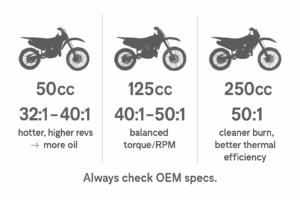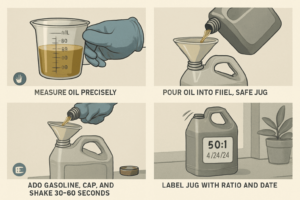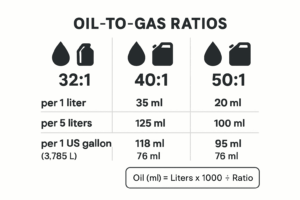Two-stroke engines, prized for their high power-to-weight ratio, depend fundamentally on a properly blended fuel mixture. But what keeps them alive isn’t just fuel, it’s the 2 stroke engine gas mix. Unlike four-stroke engines, which run on separate oil systems, 2 stroke gas mix breathe through a delicate blend of gasoline and oil. That 2 stroke gas mix is doing more than just powering the ride; it’s keeping everything inside from tearing itself apart.
In this article, we’re going through how to mix 2 stroke gas for your dirt bike in the right way, and why nailing your 2 stroke engine gas mix is important.
Table of Contents
ToggleWhat Is a 2 Stroke Gas Mix and Why It Matters for Your Dirt Bike
A 2 stroke gas mix is the lifeline of your dirt bike’s engine. It fuels the engine and lubricates it simultaneously. But get the ratio wrong, and problems show up fast. Too much oil can cause thick smoke, dirty spark plugs, and carbon buildup. Too little, you’re risking overheating, weak performance, or a seized engine.
This mix isn’t just about adding oil randomly. The type of oil, like synthetic, semi-synthetic, or mineral, matters too. Each reacts differently under pressure, heat, and cold starts. Some burn cleaner, some offer better protection. So getting this right isn’t optional; it’s part of owning and riding a machine that demands respect.
What Is a 2 Stroke Gas Mix and Why It Matters
A 2 stroke gas mix isn’t just something you put together; it’s a calculated blend of gasoline and 2 cycle oil gas mix in a precise ratio. Unlike 4-stroke engines that’ve got dedicated lubrication systems built in, 2 strokes engine gas mix depends entirely on this combination of oil and gas to stay alive. The oil doesn’t just tag along; it works quietly, reducing friction, shielding internals, and letting everything flow the way it’s meant to. Gas handles the combustion. Oil handles survival.
And that’s where things get tricky. Too much oil in the mix? You’ll start noticing sluggish response, heavy smoke, plugs fouling, and carbon where it shouldn’t be. That’s the fast track to heat damage, scratched cylinders, metal grinding where there should be glide, and sometimes engines giving up altogether.
So while it might seem like a small task, getting the 2 stroke engine gas mix right is one of those things that separates casual riders from those who understand what’s happening beneath the throttle.
Understanding Oil-to-Gas Ratios
The oil-to-gas ratio simply tells you how much fuel corresponds to a given amount of oil. But underneath that simplicity lies a delicate balance that directly shapes how your engine performs, or how it fails. Some of the most widely used ratios include:
- 50:1 – Typically aligned with modern manufacturer specs
- 40:1 – A balanced middle ground offering both solid lubrication and sharp performance
- 32:1 – Richer blends, often favored for high-rev scenarios or aging engines needing extra care
Manufacturer Guidelines vs. Real-World Riding Realities
OEM figures serve well as a blueprint. But the real world? It’s messier. Terrain changes, heat spikes, altitude shifts, and the way you ride shift with them. Riders pushing their bikes through extended high-RPM loads or hot environments often lean toward slightly richer mixes. Not because the manual said so, but because the engine feels the difference.
The Formula for 2 Stroke Engine Oil Gas Mix
To get your proportions right without guessing, this formula helps:
Oil (ml) = (Liters of Gas × 1000) ÷ Ratio
Mixing at 40:1
Your ratio is 40:1, and you have 5 liters of gas. You can calculate it with the help of the formula.
- Oil = (5 × 1000) ÷ 40 = 125 ml of oil
Mixing at 50:1
If you got 2 liters of gas at 50:1.
- Oil = (2 × 1000) ÷ 50 = 40 ml of oil
Measuring Accuracy Matters
Use a graduated measuring cup or syringe with clear milliliter (ml) markings. Small errors can throw off the ratio and affect performance, especially with smaller fuel amounts.
Common Capacity Conversions
- 1 liter = 1000 ml
- 1 US gallon ≈ 3.785 liters
- 1 oz ≈ 29.57 ml
- 100 ml ≈ 3.4 oz
Mixing Recommendations by Engine Size (50cc vs. 125cc vs. 250cc)
When it comes to 2 stroke gas mix, displacement changes everything. What works for a 250cc won’t always sit right with a smaller 50cc.

50cc Dirt Bikes
These smaller engines generate more head per cm³.
- Suggested Ratio: 32:1 or 40:1
- Why It Matters: Smaller engines run hotter and rev higher, so they need more lubrication to stay cool and protected
125cc Dirt Bikes
These 125cc dirt bike engines are light enough for agility, strong enough for power, and versatile enough for varied terrain.
- Suggested Ratio: 40:1 to 50:1
- Why It Matters: This class balances torque and RPM, so the mix has to support both short bursts and long rides
250cc Dirt Bikes
Bigger engines breathe easier and hold heat better, but they still need the right blend to stay sharp.
- Suggested Ratio: 50:1
- Why It Matters: With lower RPM reliance and improved thermal efficiency, these engines do well with a leaner mix
Why Engine Size Impacts the Mix
Smaller engines ignite more often and with tighter tolerances, so every cycle runs hotter and harder, meaning more oil is needed just to survive the pace. Larger engines, on the other hand, manage heat better and often benefit from a cleaner burn. Which is why getting this part right doesn’t just protect your engine, it helps you ride the way the machine was built to.
Race vs. Everyday Riding – Mixing Strategies Compared
Every ride places different stress on your engine, and your 2 stroke gas mix should adapt accordingly. Racing demands richer blends; trail cruising calls for cleaner, leaner ratios.
For Racing
This is where engines live near the redline, hard acceleration, high RPMs, and no room for error.
- Suggested Ratio: 32:1 or richer
- Why It Works: Constant stress and heat demand more lubrication just to keep parts from grinding down
- What You Gain: Maximum protection for pistons, bearings, and internals when riding gets aggressive
For Trail or Casual Use
Every day rides are gentler, lower throttle, cooler temperatures, and less mechanical punishment.
- Suggested Ratio: 50:1 or even slightly leaner
- Why It Works: Lower loads allow for reduced oil without risking wear
- What You Gain: Cleaner burns, less smoke, and plugs that last way longer
Terrain & Altitude, More Than Just Background
When you’re riding high, things change accordingly. In thin air at altitude, engines run leaner and hotter, which often calls for just a bit more oil in the mix to balance things out. On loose sand or sticky mud, the throttle’s constantly working, up, down, back again, so your engine’s under variable stress. Richer mixes in these cases offer just enough cushion when things get unpredictable.
One Smart Rule is Test Before You Ride Big
Always start with small batches before big rides or races. See how the engine responds. Feel the throttle. Listen closely. Then fine-tune if you need. Because when it comes to mixing 2 stroke gas, it’s not just about numbers, it’s about knowing what your ride needs.
Tools You Need for Mixing 2 Stroke Gas Properly
The right 2 stroke oil gas mix starts with having the proper tools on hand. Precision doesn’t come by guessing, and the wrong container or stale fuel can throw off everything. Here’s what should be in your setup:
- 2 Stroke-Specific Oil: Ideally, go with synthetic or semi-synthetic for cleaner burns and better protection
- Unleaded Gasoline: Always use fresh, high-octane gasoline if you want consistent performance
- Graduated Measuring Container: One with milliliter markings for exact oil amounts, no room for eyeballing here
- Fuel-Safe Mixing Jug: Built to handle premix fuel without breaking down over time
- Funnel: Keeps things clean, avoids waste, and helps with those tight pours
- Oil Ratio Bottles (Optional): Handy when you’re in a rush or want pre-measured simplicity
Step-by-Step: How to Mix 2 Stroke Gas the Right Way

Mixing isn’t just about throwing oil and gas together; it’s a process, and getting it right makes all the difference out on the trail.
- Choose the correct oil and gas: Use high-grade 2 stroke oil, preferably synthetic, and always go with fresh, high-octane gasoline. Old fuel throws off the whole mix.
- Measure the exact oil ratio: Don’t eyeball it. Use the correct formula and measure oil in milliliters based on your ratio. Precision here means engine safety.
- Add oil to the gas can: Pour oil into a clean, empty fuel can. This helps it mix better once gas is added.
- Shake/mix thoroughly: Seal the can and shake for a solid 30–60 seconds. You want full, even blending, not layers.
- Label and store it correctly: Mark the container with the ratio and date. Store it in a cool, dry place; fuel loses quality fast if left in poor conditions.
Never mix directly in the fuel tank. It causes uneven blending, and your engine will feel it, and so will you
Common Mistakes to Avoid When Mixing 2 Stroke Gas
Avoid these pitfalls to maintain peak engine health:
- Incorrect ratios are always calculated; don’t estimate
- Using dirty containers can introduce contaminants and water
- Skipping the shake, incomplete mixing leads to uneven combustion
- Storing for too long, degraded fuel loses combustibility
- Unlabeled containers, risks of using expired or incorrect mixtures
Each error can lead to mechanical failure or unnecessary service costs.
Troubleshooting Common 2 Stroke Mix Issues
Even small errors in fuel blending can throw your ride off. Here’s how to catch and correct the usual culprits:
- Excessive Smoke: Often a sign of too much oil. Try leaning the mix to 50:1 and watch the exhaust behavior.
- Hard Starts or Stalling: Usually caused by stale or poorly blended fuel. Drain it out, refill with a fresh, properly mixed batch.
- Fouled Spark Plug: Too much oil or low combustion temps can be the cause. Clean or replace the plug and double-check your ratio.
Maintaining a 2 stroke engine gas oil mix is key to long-term reliability and peak performance.
Safety Precautions When Handling Fuel
Mixing 2 stroke gas isn’t just about ratios; it’s also about safety. Fuel is flammable and should be handled with care. Follow these simple rules:
- Mix in open or well-ventilated spaces to avoid breathing in harmful fumes.
- Wear gloves and safety glasses to protect your skin and eyes from splashes.
- Use fuel-safe containers only; regular plastic can leak or break down.
- Never smoke or use open flames near your mixing area.
- Clean up spills immediately to prevent fire hazards.
- Keep a small fire extinguisher nearby just in case.
Staying safe is just as important as getting the mix right.
Storage Tips for mixing 2 stroke oil with gas
Shelf Life
- Mixed gas has a lifespan of 30–45 days under ideal storage conditions
Storage Guidelines
- Use airtight, fuel-safe containers
- Store in cool, shaded environments
- Avoid plastic containers that may leach or degrade over time
Disposal
- Do not pour old mix into the ground or drains
- Dispose of via local hazardous waste collection centers
BSE Motor’s Dirt Bike Solutions for Business Clients
BSE Motor supplies high-performance 2 stroke dirt bikes and precision-engineered components, designed specifically to meet the operational needs of dealerships, wholesalers, and service centers.
Why Partner with BSE Motor?
- Scalable bulk-order solutions for volume-driven resellers
- OEM-grade components backed by trusted brand affiliations
- Global logistics and export facilitation across key markets
- Competitive pricing with tailored product specifications
Whether you’re expanding a regional distribution network or optimizing service offerings, BSE Motor provides the mechanical consistency and supply agility your business demands.
Final Thoughts:
Refining your 2 stroke gas oil mix isn’t optional; it’s fundamental for any rider or technician who takes engine health seriously. When the ratio is accurate, the tools are precise, and storage is handled right, your machine doesn’t just last, it performs.
And if you’re aiming higher, explore BSE Motor’s high-performance dirt bikes, engineered for precision, built for both passionate riders and professional partners alike.
Now that you know how to mix 2-stroke gas for optimal engine performance, it’s important to ensure your carburetor is properly tuned to match. Learn how to jet your carburetor for better fuel delivery and engine efficiency in our detailed guide, How to Jet a Carburetor.
FAQs
Can I use synthetic 2 stroke oil?
Absolutely. Synthetic 2 stroke oil is not only safe, it’s often recommended. It combusts more cleanly, minimizes deposit formation, and withstands elevated temperatures far better than conventional mineral-based alternatives.
What if I use too much oil in my mix?
An excessive oil ratio can result in heavy exhaust smoke, spark plug fouling, and internal carbon buildup. If noticed, drain the tank entirely and replace it with a properly calibrated two stroke gas mixture.
Can I mix gas and oil for 2 stroke engine in freezing weather?
Yes, though low temperatures can increase oil viscosity and hinder proper blending. In colder climates, opt for synthetic oil for improved flow, and agitate the mix thoroughly to ensure 2 stroke oil gas mix.
What’s the difference between 2 stroke and 2 cycle oil?
None. Both terms are interchangeable and refer to lubricants specifically formulated for use in 2 stroke engine gas mixes.

